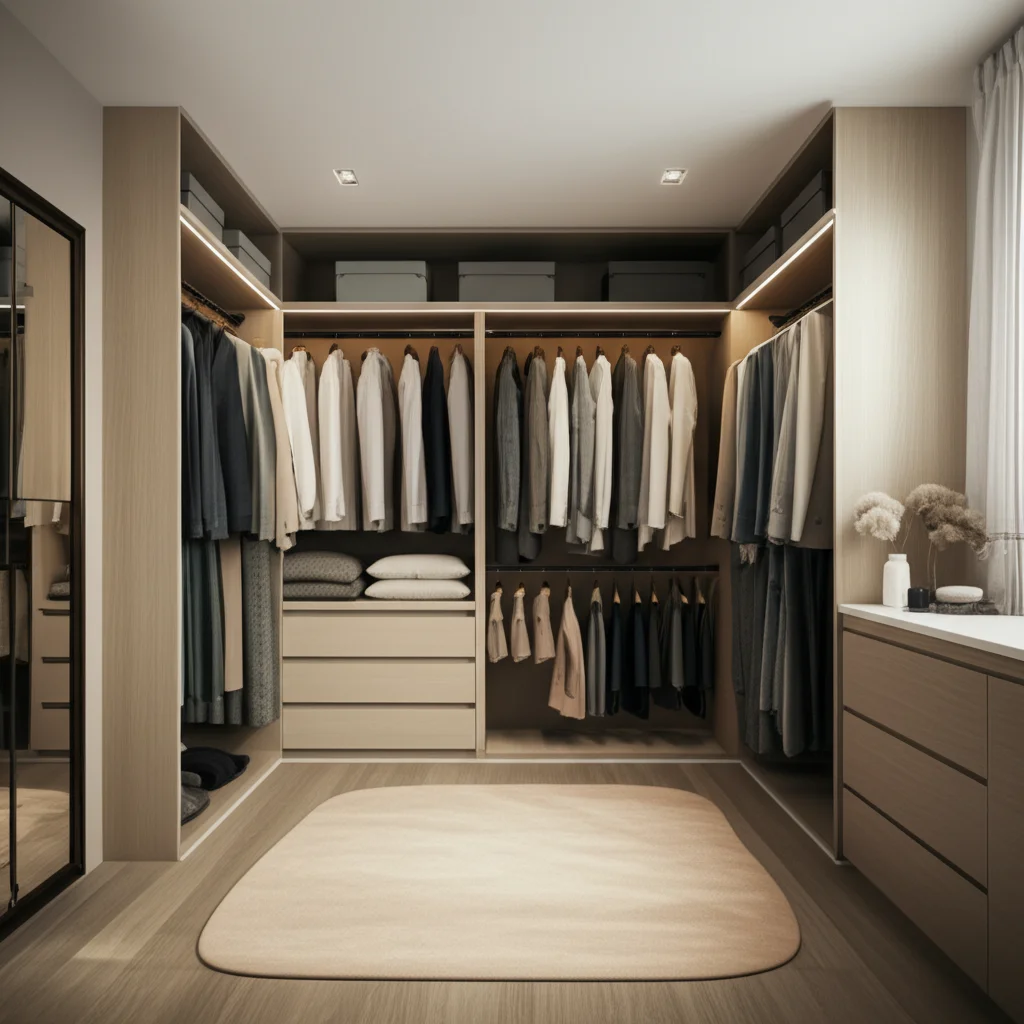· Todd Martin · Home Improvement · 17 min read
How To Build A Walk In Closet In An Existing Room

Build a Walk-In Closet in Your Existing Room
Imagine a place for every garment, every pair of shoes, and every accessory. Many people dream of a spacious, organized walk-in closet. For some, this dream feels out of reach without building a new home. However, you can achieve this luxury by converting an existing room.
I have seen many small bedrooms or underutilized spaces transformed into incredible walk-in closets. This project adds significant value and functionality to your home. This guide will show you how to build a walk-in closet in an existing room. We cover everything from initial planning to the final organizational touches. Prepare to unlock your home’s storage potential.
Takeaway
Building a walk-in closet in an existing room involves several key steps:
- Careful planning and design to maximize space.
- Structural modifications like framing new walls and installing a door.
- Finishing work, including drywall, painting, and flooring.
- Installing interior organization systems.
- Adhering to local building codes for safety and compliance.
To build a walk-in closet in an existing room, you must plan the layout, frame new walls, install drywall and electrical, finish the surfaces, and then install custom storage systems. This process transforms a standard room into a dedicated, organized storage area for clothes and accessories.
Planning Your Walk-In Closet Design
Creating a walk-in closet begins with thorough planning. This initial phase sets the foundation for your project’s success. You must assess the chosen room and define your specific needs. A good plan prevents issues later.
First, identify the best room for conversion. Consider spare bedrooms, large hallways, or underutilized dens. Measure the room’s dimensions precisely. Note down the location of windows, existing doors, and electrical outlets. These elements affect your design choices.
Next, decide on the layout of your new walk-in closet. Popular layouts include L-shape, U-shape, or parallel walls. The best choice depends on the room’s size and shape. A U-shape provides maximum hanging and shelf space. An L-shape works well for smaller square rooms. Parallel walls suit longer, narrower spaces. Draw out potential designs on paper or use a digital design tool. This step helps visualize the space.
Consider the items you plan to store. Do you have many long dresses, suits, or shoes? Will you need drawers for folded clothes or specific compartments for jewelry? Your current wardrobe dictates the amount of hanging space, shelving, and drawer units you will need. Think about future needs too. It is smart to plan for growth.
Set a realistic budget for your project. Include costs for materials like lumber, drywall, flooring, and paint. Factor in the cost of interior closet systems, lighting fixtures, and any tools you might need. Obtaining quotes for materials helps you stay within budget. Unexpected expenses can arise, so allocate a small contingency fund. This financial planning is crucial for managing your project effectively.
Finally, research local building codes and obtain any necessary permits. Some structural changes require official approval. Check with your local building department before you start any work. Ignoring permits can lead to fines or a requirement to undo completed work. Safety and compliance are paramount.
Demolition and Room Preparation
Once your plans are complete and permits are in hand, it is time to prepare the room. This phase involves clearing the space and preparing for the new structure. A clean and empty room makes the building process smoother.
Start by removing all existing furniture and personal items from the room. Move them to another area where they will not obstruct your work. Cover any items you cannot remove with drop cloths to protect them from dust and debris. Construction work generates a lot of dust, so protection is important.
Next, remove any existing closet doors, baseboards, or trim that will be affected by the new construction. Use a pry bar carefully to avoid damaging walls or floors you plan to keep. If you are changing the room’s flooring, this is a good time to remove old carpeting or tiles. Clear away all removed materials promptly.
Inspect the walls and ceiling for any damage or irregularities. Patch any holes or cracks in the existing drywall. Ensure all surfaces are clean and free of dirt or grease. A clean surface helps new materials adhere properly. If you plan to reroute or add electrical wiring, mark the locations on the walls for future reference.
Thoroughly clean the room. Sweep and vacuum the entire space to remove dust and small debris. You want a clear workspace for accurate measurements and safe construction. A clean start promotes a clean finish. Consider using a shop vacuum for heavy dust. After removing clutter, you might want to give the room a good cleaning. Learning how to clean a room checklist can guide you through preparing the space. A well-prepared room provides a solid foundation for your new walk-in closet project.
Framing the New Closet Structure
Framing is the skeleton of your new walk-in closet. This step creates the new walls and door openings. Precision in framing ensures square corners and strong support for future finishes. I remember how satisfying it felt to see the room’s new shape emerge during this stage.
Begin by marking the layout of your new walls on the floor using a chalk line. Measure carefully to ensure the lines are straight and square. Use a framing square to check all corners for 90-degree angles. Accuracy here prevents issues with drywall and door installation later. Double-check your measurements against your design plan.
Cut lumber for the top and bottom plates of your new walls. These pieces run horizontally along the floor and ceiling. Secure the bottom plate to the floor. Use appropriate fasteners for your flooring type, whether concrete, wood subfloor, or existing finished floor. Then, secure the top plate to the ceiling joists. Use a stud finder to locate ceiling joists for strong attachment.
Next, cut and install the vertical studs between the top and bottom plates. Space studs typically 16 or 24 inches on center. This spacing provides strong support for drywall. Use a level to ensure each stud is perfectly plumb. Attach studs securely with nails or screws. Build strong corners by doubling up studs.
Create openings for your new closet door. Frame out the door rough opening according to the door manufacturer’s specifications. This involves installing vertical king studs, jack studs, and a horizontal header above the door opening. The header supports the weight above the door. Ensure the rough opening is square and plumb.
If your design includes any interior partitions for distinct zones within the closet, frame these now too. Treat them as smaller versions of the main walls, following the same plate-and-stud method. Every piece of wood adds to the stability and shape of your new closet. Always wear safety glasses and gloves when cutting and handling lumber.
Electrical and Drywall Installation
With the framing complete, the next critical steps involve electrical work and drywall installation. These stages transform the raw wooden frame into functional, finished walls ready for decoration. Safety is a top priority when dealing with electricity.
First, address any electrical needs. This might include adding new lighting fixtures inside the closet, installing new outlets, or moving existing switches. Consult with a licensed electrician or ensure you have the proper knowledge to perform electrical work safely and to code. Run new wiring through the framed walls and ceiling. Secure wires properly to studs and joists. Leave enough wire length at each box for connections. All electrical boxes must be installed and secured before drywall goes up.
Once electrical rough-in passes inspection (if required), you can begin hanging drywall. Measure and cut drywall sheets to fit your framed sections. Use a utility knife to score and snap the sheets. Fasten drywall sheets to the studs and ceiling joists using drywall screws. Space screws every 6-8 inches. Ensure the panels are flush and tight against each other. Start at the top of the walls and work your way down.
After all drywall panels are installed, apply drywall tape to all seams and corners. This tape reinforces the joints. Then, apply thin coats of drywall compound (mud) over the tape and screw heads. Use a drywall knife to spread the compound smoothly. Allow each coat to dry completely before applying the next. You will typically need two to three coats, sanding lightly between each. This process creates a smooth, seamless surface.
Sanding is crucial for a professional finish. Use fine-grit sandpaper to smooth out any bumps or ridges from the drywall compound. Ensure the entire surface is flat and ready for primer and paint. Clean up the drywall dust thoroughly after sanding. This dust is very fine and can get everywhere.
Flooring, Painting, and Trim
With the walls smooth and dust-free, it’s time to bring color and polish to your new walk-in closet. This stage involves installing new flooring, painting the walls, and adding decorative trim. These elements give the closet its finished look and feel. I always find this part rewarding, as the space truly starts to resemble a closet.
Start with the flooring. If you removed the old flooring, install your chosen new material. Common choices for closets include hardwood, laminate, luxury vinyl plank (LVP), or carpet. Hardwood and LVP offer durability and a clean look. Carpet adds warmth and softness underfoot. Follow the manufacturer’s instructions for your specific flooring type. Ensure the subfloor is clean, level, and dry before installation. Proper flooring installation provides a stable base for your closet system.
Next, prepare for painting. Apply a coat of primer to all new drywall surfaces. Primer helps the paint adhere better and provides a uniform base color. Choose a paint color that complements your home’s decor and your personal style. Lighter colors can make a small closet feel more spacious. Apply at least two coats of paint for full coverage and a durable finish. Use painter’s tape along edges and ceilings for crisp lines. Allow each coat to dry completely.
Once the paint is dry, install baseboards and door trim. Baseboards protect the bottom of the walls and provide a finished look where the wall meets the floor. Door trim frames the entrance to your walk-in closet. Measure and cut the trim pieces precisely. Use a miter saw for clean 45-degree angle cuts at corners. Secure trim with finish nails. Fill nail holes with wood putty and touch up with paint. This small detail greatly enhances the room’s appearance.
Lastly, install the closet door. Follow the door manufacturer’s instructions for installation. Ensure the door swings freely and latches properly. Adjust hinges if needed for perfect alignment. A well-installed door completes the entry to your new walk-in closet. These finishing steps make your new space truly shine.
Designing and Installing Interior Closet Systems
The heart of any walk-in closet lies in its interior organization system. This is where your vision for efficient storage comes to life. A well-designed system maximizes every inch of space, making your closet functional and beautiful. I find organizing my space incredibly satisfying, and it starts with the right system.
Begin by assessing your storage needs one last time. Consider the types of clothes you own: long hanging, short hanging, folded items, shoes, and accessories. This assessment guides your choice of components. Many ready-made closet systems exist, or you can opt for custom-built solutions. Ready-made systems often feature adjustable shelving, hanging rods, and drawers. Custom systems offer precise fit and personalized features.
Map out the exact placement of shelves, rods, and drawers on your walls. Use a level and tape measure to mark stud locations. Mark the heights for double hanging rods, single hanging rods, and shoe shelves. Typically, double hanging rods are around 40-42 inches apart, while single rods are about 66-70 inches from the floor. Plan shelving depth to fit your folded items or baskets.
Install the main support rails or cleat strips first. These components bear the weight of your system. Secure them firmly into wall studs for maximum stability. Use heavy-duty screws designed for closet systems. Ensure these supports are perfectly level. A crooked rail will lead to uneven shelves and rods.
Next, install the vertical uprights or side panels. These pieces connect to the support rails and hold the shelves and rods. Slide or attach shelves into place according to your marked layout. Install hanging rods at the appropriate heights. Many systems use metal brackets or cams for easy assembly. If using wooden shelves, secure them with shelf pins or screws.
Add specialized storage components. This includes shoe racks, tie and belt racks, jewelry drawers, or pull-out hampers. These additions enhance functionality. Install them at convenient heights and locations. A well-organized closet saves you time and stress. After installing the system, you might want to give it a thorough cleaning. Knowing how to clean closet organizing components will help maintain their appearance. For more detailed advice on maintaining your space, explore tips on how to clean your closet out periodically. You can also learn how to deep clean your closet for a complete refresh.
Final Touches and Organization
Once your interior closet system is installed, it is time for the exciting part: adding the final touches and organizing your belongings. These steps make your new walk-in closet truly feel complete and ready for use. A well-organized space makes a significant difference in daily life.
Install any additional lighting fixtures you planned. This might include ceiling lights, LED strip lighting inside shelving units, or vanity lights near a mirror. Good lighting is essential for visibility and creating a pleasant atmosphere in your closet. Ensure all wiring is safely enclosed and connections are secure. Dimmer switches can add versatility to your lighting scheme.
Add a full-length mirror. A mirror is a practical and aesthetic addition to any walk-in closet. Mount it on a wall that provides a clear view, perhaps opposite the main entry or in an area with good lighting. Choose a mirror style that complements your overall decor. This makes outfit selection much easier.
Consider other decorative elements. A small rug can add warmth and define the space. Wall art or decorative boxes can personalize the closet. Choose items that reflect your style but do not take up too much valuable storage space. Your closet should be a pleasant and inviting space.
Now, it is time to move your clothes and accessories into their new home. This is the moment to put your carefully designed organization system to use. Group similar items together. Hang shirts with shirts, pants with pants, and dresses with dresses. Use uniform hangers for a neat look. Store out-of-season clothing in clear bins on high shelves. This keeps them tidy and visible.
Arrange shoes on shoe racks or in cubbies. Fold sweaters and t-shirts neatly on shelves or in drawers. Use drawer dividers to keep smaller items like socks, undergarments, and accessories organized. Purses can hang on hooks or stand upright on shelves. The goal is to make everything easily accessible and visible. A truly organized closet simplifies your daily routine. For ongoing tidiness, consider strategies on how to keep your room clean and organized. Remember, a little regular effort goes a long way.
Maintaining Your New Walk-In Closet
Building a walk-in closet is a significant project. Keeping it functional and beautiful requires ongoing maintenance. This includes regular cleaning and smart organization habits. A well-maintained closet serves you better and longer.
Regular cleaning prevents dust and dirt buildup. Dust can accumulate on shelves, rods, and even your clothing. Establish a routine for dusting surfaces with a microfibre cloth. Vacuum or sweep the floor regularly to remove lint and debris. For a deeper clean, occasionally wipe down all shelves and drawers with a mild cleaner. This keeps your closet looking fresh.
Beyond general cleaning, periodically review your closet’s contents. This helps you identify items you no longer need or wear. Over time, closets can become cluttered again if you do not manage inventory. Schedule a seasonal decluttering session. Remove items that no longer fit, are damaged, or you haven’t worn in over a year. Donate or discard these items. This keeps your space optimized.
Check the condition of your closet system components. Ensure shelves are still level and rods are securely fastened. Tighten any loose screws on brackets or drawer slides. Address any wear and tear promptly. Early intervention prevents minor issues from becoming major repairs. A sturdy system supports your clothes effectively.
Consider the ventilation in your closet. Good airflow helps prevent mustiness and mildew, especially in humid climates. If your closet lacks ventilation, consider adding a small fan or using moisture absorbers. Keep the closet door slightly ajar sometimes to allow air circulation. Proper ventilation protects your clothes and the closet structure.
Lastly, adapt your organization as your wardrobe changes. If you acquire new items, find a designated spot for them. Reorganize sections if a particular area becomes too crowded. Flexibility in your system allows it to grow with you. Regularly reviewing how to clean a closet can give you fresh ideas for maintenance. For more intensive clean-outs, I find that reviewing how to clean out my closet helps me reset. Your walk-in closet is an investment in your home and your daily life, so treat it with care.
Frequently Asked Questions
What is the minimum room size needed for a walk-in closet?
A comfortable walk-in closet generally needs a minimum of 6 to 7 feet by 6 feet of clear floor space. This allows for about 24 inches of depth for hanging clothes on each side and at least 3 feet of walk space in the middle. Smaller rooms may accommodate a reach-in or L-shaped system.
Do I need a permit to build a walk-in closet in an existing room?
Yes, you likely need a permit. Building new walls, altering electrical wiring, or changing the use of a room often requires a building permit. Check with your local municipal building department before starting work. Rules vary by location, and getting a permit ensures your project meets safety codes.
How much does it cost to build a walk-in closet in an existing room?
The cost varies greatly based on size, materials, and whether you DIY or hire professionals. Expect to spend anywhere from $1,000 for a basic DIY project with simple materials to $10,000+ for a custom-built, professionally installed closet with high-end finishes. Factor in lumber, drywall, electrical, flooring, paint, and closet systems.
Can I build a walk-in closet without a window?
Yes, many walk-in closets do not have windows. Good lighting is essential, so plan for adequate artificial lighting instead. This includes ceiling fixtures, LED strip lighting within shelving, or even a small chandelier. Proper ventilation is also important if there is no window.
What are common mistakes to avoid when building a walk-in closet?
Common mistakes include not planning enough storage for specific items (like shoes), inadequate lighting, poor ventilation, and neglecting building codes. Also, failing to measure accurately can lead to costly material waste. Always plan meticulously and consult professionals when unsure about any step.
How long does it take to build a walk-in closet in an existing room?
The timeline depends on project complexity and your DIY experience. A basic conversion might take 1-2 weeks of concentrated effort. More complex projects involving significant electrical or structural changes could take 3-4 weeks or longer. Hiring professionals shortens the active construction time, but planning takes time regardless.
Conclusion
Creating a walk-in closet from an existing room is a rewarding home improvement project. It transforms an underused space into a highly functional and luxurious storage area. We covered everything from initial planning and structural modifications to the final aesthetic and organizational details. My hope is this guide gives you the confidence to start your own project.
Remember, careful planning, adherence to safety standards, and attention to detail are key. You will enjoy the added convenience and beauty of your new space. A well-designed walk-in closet simplifies your daily routine and adds significant value to your home. Are you ready to organize your wardrobe like never before? Begin planning your dream walk-in closet today.





